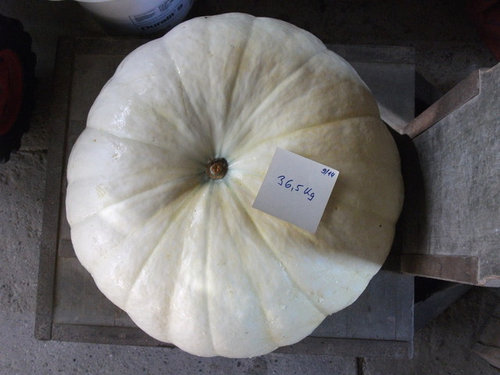Cucurbita maxima boer ford `Nadym�
acorneti
9 years ago
I created the biggest boer ford 'Nadym' now with an averaged weight of 30 kg (from 24 to 36).
This shiny white fruit on the old farmer's scales has 80.5 lbs. or 36,5 kg, 50 cm averaged diameter, the hight of averaged 26,5 cm and the stem-to-blossom-axis of only 20 cm.
That makes a ratio of 2,5 for diameter/sb-axis.
That's a real cheese loaf when it turns more yellowish in late winter.
This variety with now deep yellow and dark orange flesh in November is storable until spring.
Flesh is very dense and so will be best for industrial processing.
Now I have to select a few years to establish the wide and flat shape.

This post was edited by acorneti on Fri, Sep 12, 14 at 7:43
acornetiOriginal Author
slimfatty
Related Professionals
Ashland Landscape Architects & Landscape Designers · Marina Landscape Architects & Landscape Designers · Oconomowoc Landscape Architects & Landscape Designers · South Elgin Landscape Architects & Landscape Designers · Arlington Landscape Contractors · Berkley Landscape Contractors · Dickinson Landscape Contractors · Eagle Landscape Contractors · Franklin Landscape Contractors · La Mirada Landscape Contractors · Newnan Landscape Contractors · Ridgewood Landscape Contractors · Uxbridge Landscape Contractors · Wethersfield Landscape Contractors · Wilton Landscape ContractorsMacmex
acornetiOriginal Author
acornetiOriginal Author
Macmex
acornetiOriginal Author
acornetiOriginal Author
acornetiOriginal Author